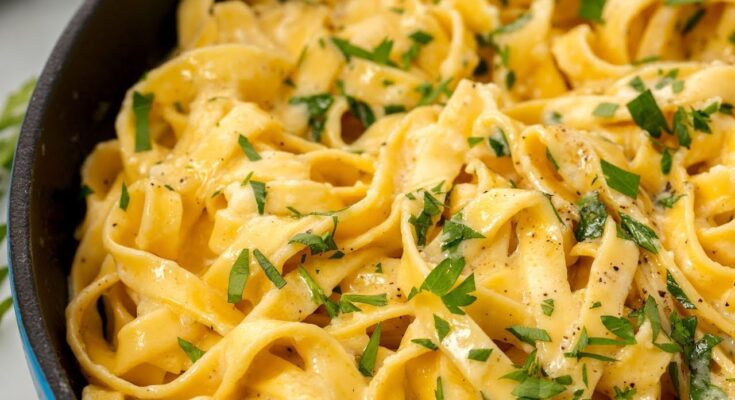Fettuccine Alfredo Recipe: Fettuccine Alfredo is a creamy, cheesy pasta dish that has stood the test of time. Originating in Italy, this recipe gained international fame for its simple ingredients and rich flavor.
The dish combines tender fettuccine with a luscious Alfredo sauce made from butter, cream, and Parmesan cheese. It’s quick, indulgent, and perfect for a cozy dinner or a fancy meal with friends.
With this guide, you’ll master the art of making this restaurant-worthy dish in your kitchen.
Ingredients
To make a classic Fettuccine Alfredo, you’ll need the following:
Essential Ingredients:
- 12 oz (340g) fettuccine pasta.
- 1 cup heavy cream.
- 1/2 cup unsalted butter.
- 1 1/2 cups grated Parmesan cheese.
- Salt to taste.
- Freshly ground black pepper.
Optional Ingredients:
- Fresh parsley for garnish.
- Minced garlic for extra flavor.
- Nutmeg for a subtle earthy note.
- Grilled chicken, shrimp, or steamed vegetables for variations.
Each ingredient plays a key role, so choose high-quality Parmesan and fresh cream for the best results.
Equipment Needed
Before starting, gather the necessary equipment:
- A large pot for boiling pasta.
- A colander for draining.
- A skillet or saucepan for making the sauce.
- A wooden spoon or silicone spatula for stirring.
- A grater for Parmesan cheese.
For even better results, use a pasta fork to mix the sauce and pasta evenly.
Step 1: Preparing the Ingredients
Preparation is key to a smooth cooking process.
- Measure and Prep: Measure out all your ingredients. Grate the Parmesan cheese finely for a smoother sauce.
- Bring Water to Boil: Fill a large pot with water and bring it to a rolling boil. Add a generous amount of salt—it should taste like the sea!
- Set Up Your Cooking Space: Keep all ingredients and equipment within easy reach.
Having everything prepped ahead of time ensures the cooking process is seamless and stress-free.
Step 2: Cooking the Fettuccine
Perfectly cooked pasta is the foundation of this dish.
- Cook the Pasta: Add the fettuccine to the boiling water and cook according to the package instructions (usually 8-12 minutes). Stir occasionally to prevent sticking.
- Taste Test: About a minute before the cooking time ends, taste a strand. You’re looking for “al dente” texture—firm but not hard.
- Reserve Pasta Water: Before draining, scoop out about 1 cup of pasta water. This starchy liquid will help emulsify the sauce later.
- Drain and Set Aside: Drain the pasta in a colander, but don’t rinse it. Rinsing washes away the starch that helps the sauce cling to the pasta.
Step 3: Making the Alfredo Sauce
The star of the dish is the creamy Alfredo sauce.
- Melt the Butter: In a large skillet, melt the butter over medium heat. If using garlic, sauté it for 1 minute to release its aroma.
- Add the Cream: Slowly pour in the heavy cream, stirring constantly. Let the mixture heat up but avoid boiling.
- Incorporate Parmesan Cheese: Gradually whisk in the grated Parmesan, ensuring it melts fully. Keep stirring until the sauce becomes silky and smooth.
- Season the Sauce: Add a pinch of salt, a crack of black pepper, and a sprinkle of nutmeg (if using). Taste and adjust seasoning.
The sauce should be creamy but not overly thick. If it seems too thick, add a splash of pasta water to thin it out.
Step 4: Combining the Pasta and Sauce
Now comes the magic moment where the pasta and sauce come together to create Fettuccine Alfredo.
- Transfer Pasta to the Sauce: Add the cooked fettuccine directly to the skillet with the Alfredo sauce. Ensure the pasta is still warm for optimal absorption.
- Mix Thoroughly: Use tongs or a pasta fork to toss the pasta in the sauce. The goal is to coat every strand evenly.
- Adjust Consistency: If the sauce is too thick, add a splash of the reserved pasta water a little at a time. This not only loosens the sauce but also enhances its creaminess.
- Taste and Adjust: Take a final taste and tweak the seasoning if necessary. Add more Parmesan for a cheesier flavor or pepper for a bit of spice.
Step 5: Serving Suggestions
Presentation can elevate the entire dining experience. Here’s how to serve your Fettuccine Alfredo like a pro:
- Plate with Care: Use tongs to twirl a portion of pasta into a neat mound on each plate.
- Garnish Creatively: Sprinkle freshly chopped parsley, a dash of Parmesan, or even a drizzle of olive oil on top for added flair.
- Serve Immediately: Alfredo sauce is best enjoyed fresh. Serve the dish piping hot to savor its creamy texture.
- Pair Thoughtfully: Pair your Fettuccine Alfredo with crusty garlic bread and a crisp salad for a complete meal.
Pro Tips for Perfect Fettuccine Alfredo
Want to take your Fettuccine Alfredo to the next level? Follow these expert tips:
- Use Freshly Grated Cheese: Pre-grated Parmesan often contains anti-caking agents, which can make the sauce grainy.
- Don’t Overheat the Sauce: High heat can cause the cream and cheese to separate, resulting in a clumpy sauce. Keep the heat low and steady.
- Reserve Pasta Water: This underrated ingredient is essential for emulsifying the sauce and achieving a glossy finish.
- Work Quickly: Alfredo sauce can thicken as it cools. Combine the pasta and sauce swiftly for the best texture.
Variations of Fettuccine Alfredo
Fettuccine Alfredo is versatile and can be customized to suit different tastes. Here are some popular variations:
Classic Alfredo
Stick to the basics with just pasta, butter, cream, and Parmesan. This timeless version highlights the dish’s original simplicity.
Chicken Alfredo
For a protein-packed twist, top your Fettuccine Alfredo with grilled or pan-seared chicken slices. Season the chicken with Italian herbs for an extra flavor boost.
Shrimp Alfredo
Add a touch of luxury with shrimp. Sauté them in garlic butter and toss them into the pasta for a seafood delight.
Vegetarian Alfredo
Brighten up the dish with colorful vegetables like broccoli, peas, or spinach. Steam or roast the veggies before mixing them with the pasta for a wholesome meal.
Spicy Alfredo
Give your dish a kick by incorporating a pinch of red chili flakes or a dash of cayenne pepper into the sauce.
Storage and Reheating Tips
Leftovers? No problem! Here’s how to store and reheat Fettuccine Alfredo without losing its creamy goodness:
Storage:
- Transfer the pasta to an airtight container and refrigerate for up to 3 days.
- Store the sauce separately if possible to avoid over-soaking the pasta.
Reheating:
- Stovetop Method: Warm the pasta in a skillet over low heat, adding a splash of milk or cream to restore its creamy texture.
- Microwave Method: Heat in short intervals, stirring frequently to prevent the sauce from separating.
Pairing Suggestions
Fettuccine Alfredo pairs beautifully with the right accompaniments. Here are some ideas:
- Drinks: A chilled white wine like Chardonnay or Sauvignon Blanc complements the creamy sauce. Non-alcoholic options include sparkling water with a splash of lemon.
- Sides: Garlic bread, Caesar salad, or roasted vegetables are excellent choices. These sides provide texture and balance to the richness of the dish.
Nutritional Information
For those curious about the nutritional profile, here’s an approximate breakdown per serving:
- Calories: 700–800 (depending on portion size and ingredients used).
- Protein: 20–25g (higher with added chicken or shrimp).
- Fats: 45–50g (mainly from cream and butter).
- Carbohydrates: 60–70g.
Want a lighter version? Swap heavy cream for half-and-half or use whole wheat pasta to increase fiber content.
FAQs about Fettuccine Alfredo Recipe
Q1: What is Fettuccine Alfredo?
Fettuccine Alfredo is a classic Italian pasta dish made with fettuccine noodles tossed in a rich and creamy sauce typically made from butter, heavy cream, and Parmesan cheese.
Q2: Can I add protein to Fettuccine Alfredo?
Yes, you can enhance the dish by adding grilled chicken, shrimp, or even sautéed mushrooms for a vegetarian option.
Q3: How do I make the sauce creamy?
To achieve a silky texture, use heavy cream and freshly grated Parmesan cheese. Stir continuously over low heat to prevent the sauce from separating.
Q4: Can I make Fettuccine Alfredo without cream?
Absolutely! You can use milk and a roux (flour and butter mixture) as a substitute for heavy cream. This creates a lighter version of the dish.
Q5: What side dishes go well with Fettuccine Alfredo?
Pair it with a fresh Caesar salad, garlic bread, or roasted vegetables for a balanced meal.
Q6: How do I store leftover Fettuccine Alfredo?
Store leftovers in an airtight container in the refrigerator for up to 3 days. Reheat gently on the stove with a splash of milk or cream to revive the sauce’s consistency.
Q7: Can I make Fettuccine Alfredo gluten-free?
Yes, substitute regular fettuccine noodles with gluten-free pasta and ensure your sauce ingredients are gluten-free.
Q8: Is Fettuccine Alfredo a healthy dish?
While it is indulgent due to its creamy and buttery nature, you can make healthier versions by using low-fat milk and reducing the butter and cheese.
Conclusion
Fettuccine Alfredo is a dish that’s as comforting as it is indulgent. With this step-by-step guide, you can recreate this creamy classic right in your kitchen. Whether you stick to the traditional recipe or experiment with variations, the result will be a crowd-pleaser every time. So, roll up your sleeves, grab your ingredients, and bring a little Italian magic to your table tonight.



